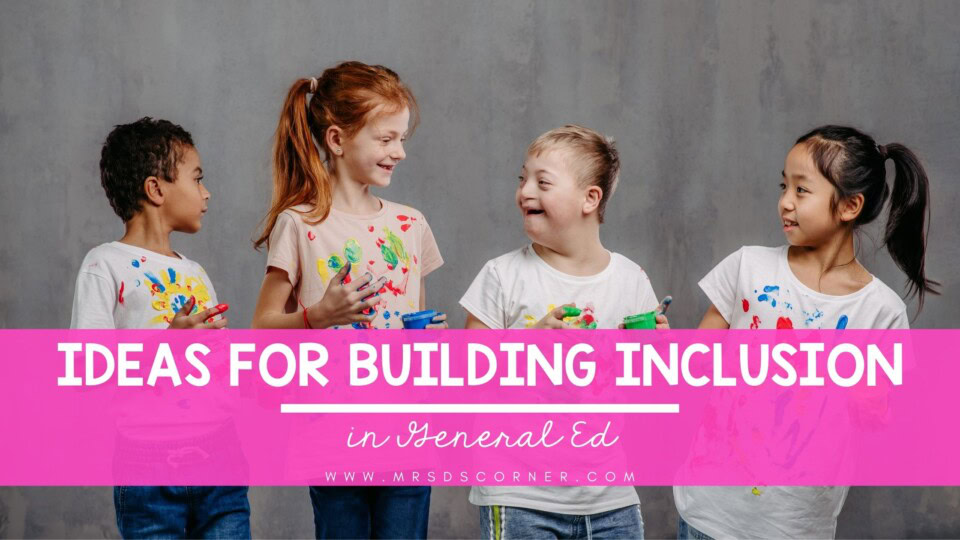Creating an inclusive classroom environment benefits all students by fostering empathy, collaboration, and a deeper sense of community.


Inclusion ensures that students with disabilities or those in special programs are not just physically present in general education (Gen Ed) classrooms but are actively engaged and valued. Below are some key strategies to build meaningful inclusion in general education settings.
1. Implement Peer Mentor and Peer Tutor Programs
One of the most effective ways to foster inclusion is through peer mentorship and peer tutoring. These programs pair general education students with students from special education or special programs, promoting natural friendships and support systems.
- Peer Mentors can be assigned in various subjects, such as PE, cooking, art, theater, and even driver’s education. These mentors help bridge gaps and ensure students feel welcome and included.
- Peer Tutors are general education students who sign up to assist in the classroom, at lunch, or during other activities. Schools can create an elective course where students apply to be peer tutors, requiring good academic standing, attendance, and teacher recommendations. Check with your National Honor Society leaders to see if students can earn volunteer hours for being a peer tutor.
- Reverse Inclusion allows students from special programs to interact with their general education peers in smaller settings before transitioning to larger group settings.
2. Build Relationships First
Before expecting students to work together seamlessly, it’s important to focus on relationship-building. Inclusion is more effective when students develop genuine friendships and trust.
- Create Icebreaker Activities: Games, partner activities, and group projects can help students feel more comfortable around each other.
- Encourage Cross-Classroom Friendships: Set up buddy systems where general education students regularly interact with their peers from special programs.
- Normalize Differences: Have open discussions about different learning styles and abilities, promoting acceptance and understanding.
3. Utilize Inclusive Teaching Practices
Making the classroom environment accessible and welcoming involves incorporating instructional strategies that support all learners.
- Use Differentiated Instruction: Adjust lesson plans to accommodate various learning styles and abilities. This could include providing materials in multiple formats, using hands-on activities, and offering various levels of support.
- Incorporate Universal Design for Learning (UDL): UDL ensures that learning experiences are accessible to all students by offering multiple means of engagement, representation, and expression.
- Provide Scaffolding and Support: Use visuals, written instructions, and peer support to help all students follow along and engage in lessons.
4. Create an Inclusive Classroom Culture
A welcoming and inclusive classroom starts with the teacher setting a positive example and encouraging inclusive behavior among students.
- Model Inclusive Language and Behavior: Teachers should use person-first language and emphasize strengths over challenges.
- Promote a Growth Mindset: Encourage all students to see learning as a journey and celebrate effort, not just results.
- Encourage Student Leadership: Give students roles in fostering inclusion, such as inclusion ambassadors or peer coaches.
5. Provide Structured Inclusive Activities
Structured activities ensure that students with diverse abilities can participate meaningfully in the classroom and social settings.
- Collaborative Group Work: Assign mixed-ability groups for projects to encourage teamwork and peer learning.
- Playground and Lunch Buddies: Pair students for recess or lunch to create opportunities for socialization in a natural setting.
- Themed Reading Activities: Schedule inclusive read-aloud sessions where all students can participate in discussions and related activities.
6. Train Teachers and Staff in Inclusive Practices
Ensuring that educators have the tools and knowledge to support inclusion is crucial.
- Professional Development: Offer training on inclusive strategies, disability awareness, and communication techniques.
- Encourage Collaboration Between Special and General Education Teachers: Co-teaching and shared lesson planning help create a seamless and supportive learning environment.
7. Get Administrative and Community Support
Inclusion is most successful when it is a school-wide effort supported by administrators, staff, and the broader community.
- Develop School-Wide Inclusion Initiatives: Implement policies that encourage inclusive practices across all classrooms and grade levels.
- Engage Parents and Guardians: Encourage families to be part of the inclusion efforts through communication, events, and volunteer opportunities.
- Invite Administrators to Observe Inclusion in Action: Show how inclusion works effectively through real-life classroom experiences.
Building inclusion in general education classrooms takes intentional effort, but the benefits extend to all students. By fostering peer relationships, implementing inclusive teaching practices, and encouraging a supportive school culture, teachers can create classrooms where every student feels valued and engaged. Inclusion isn’t just about placement—it’s about belonging.

